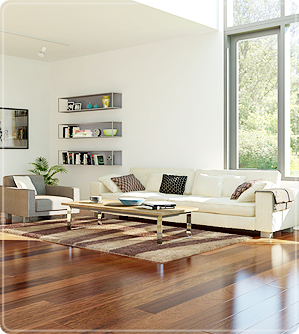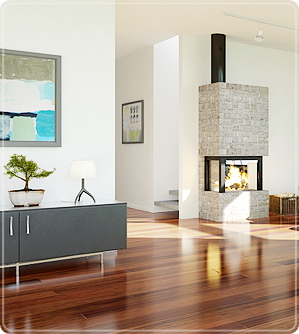Wood floors, properly finished, are the easiest of all floor surfaces to keep clean and looking new.
A good rule of thumb is to vacuum or sweep the floor weekly. A damp mop can be used for spills and, when necessary, general cleaning of floors which have a non-waxed polyurethane or a similar surface finish. When areas of surface finish begin to show significant wear, lightly sanding the finished surface and re-coating an entire floor is the least involved choice for maintenance.
If a floor is oiled, occasional buffing helps renew the shine and remove scuff marks that may appear in the oil coating.
If the shine cannot be renewed in heavily used areas, re-oiling may be necessary. Intervals for completely re-oiling a floor may extend to a year or longer if attention is paid to proper care.
Preventative Maintenance
Preventative maintenance is a term more common to industrial floor care than to residential or office floor care, but its importance cannot be over-emphasized. Good preventative maintenance lengthens the intervals between the major renovation operations such as re-coating, re-waxing and refinishing. Here are some basic rules that apply to all types of floor finishes.

Keep grit off the floor
Use dirt-trapping mats at all exterior doors to help prevent dirt, grit and sand from getting inside the building. Rugs or small sections of carpet just inside the entrances are also recommended. Dirt and grit is any floor’s worst enemy, and that includes carpets and vinyl as well as hardwoods. Keep door mats clean.
UV light sources
Finishes (and certain chemicals in wood) oxidize and are affected by ultra violet light sources. This may cause the wood and the finish to change colour and develop a patina – or aged appearance. To avoid uneven appearance, move rugs occasionally and drape or shade large windows.
Vacuum regularly
As often as you vacuum carpets – maybe even more often. A brush attachment works beautifully. Sweep or use a dust mop as needed, but do not use household dusting treatment sprays as these may cause your floor to become slick, dull the finish, or interfere with re-coating.
Wipe up spills
Wipe up food and other spills promptly with a dry cloth or paper towel. Use a slightly moistened cloth for sticky spills if necessary. Then wipe the floor dry with another cloth or paper towel.
Take your shoes off
Heels on shoes need to be in good repair, especially high heels. Heels that have their protective cap missing or worn away (exposing the steel support rod) will dent any floor surface, even concrete.
By observing these simple suggestions you’ll go a long way toward keeping your hardwood floors beautiful and making their care easier.
Stop furniture scratching the floor
Put felt pads on the legs of your furniture; they allow furniture to be moved easily without scratching the floor. Clean the pads regularly as grit can become embedded in them. Some furniture may require barrel type roller casters as ball type casters may cause damage. Grey, non-marking rubber casters are the best. Avoid casters made of hard materials like metals or hard plastics.

FREE QUOTE
To arrange a free quote, simply fill out this form, and we will get in touch with you today.
